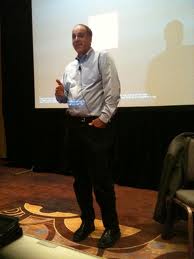More trends from 2010 that will have an impact on design and engineering technology in 2011.
The computer-aided design and engineering graphics industry normally doesn’t change a lot from one year to the next. It’s been guided by a philosophy of ‘AutoCAD is AutoCAD, Catia is Catia, and ne’er the twain shall meet.’ But all that started falling apart in 2010, and things are only going to get more interesting in 2011.
This is the second article; click here for part 1.
3D printing hits the jackpot
We include 3D printing in our CAD reporting because it couldn’t exist without the 3D geometry output from CAD software, and because the end product is the ultimate in computer graphics. In the third quarter of 2010, leading 3D printer manufacturer Stratasys reported revenue up 24% from a year earlier. Part of the increase could be attributed to the increase in the sale of consumables to existing users, who printed more 3D models as business improved. But much more of the increase was due to their new distributor, HP. It was the first quarter the marketing collaboration contributed significant revenue.

Stratasys says within HP markets, total 3D printer unit volume—which includes the HP-branded HP DesignJet—expanded by 88% over 2009. “Our game-changing collaboration with HP continues to generate positive results,” said CEO Scott Crump in reporting the results. “HP orders remained strong during the third quarter and end-customer demand for their new Designjet 3D printer continued to build.”
HP has resurrected the simple sales plan that took it from zero to the top in large format printing: Find a good technology partner, sell in one market region until you work out all the kinks, and then take it global, region by region. It is exactly what is happening in selected Western European nations, and the results have exceeded expectations. We expect them to expand sales to at least one other region, probably Asia/Pacific, in 2011, and be global in 2013. North America will probably be the last market they enter.
3D printing, also known as additive fabrication, is still a tiny industry with great but largely unrealized potential. The arrival of HP is a game-changer for two reasons. The first is brand recognition. A mid-level manager may not be able to sell a boss on the technical reasons for additive fabrication if he’s unfamiliar with the company. Being able to say “let’s buy an HP DesignJet for this” practically makes the purchase order sign itself. The second is marketing reach. The HP channel is second to none in high tech. By the end of 2011 every small manufacturer and design studio—not just the big manufacturers—in HP’s target markets will have been given a personal demonstration of how 3D printing can have a positive impact on business.

Success at Stratasys will help all 3D printing companies by raising awareness—but not directly. Some of the smaller players—specifically one-time market leader 3D Systems—may need to merge or find an owner with deeper pockets to move along with Stratasys to the next level. Expect at least one such realignment in 2011.
Cloudy with a chance of progress
![]() 2010 will be remembered as the year CAD companies parted over clouds. Among the largest companies, Dassault Systémes and Autodesk are lining up as enthusiasts for bringing cloud computing to CAD, PTC is actively dissing the technology, and Siemens PLM is taking a wait and see attitude.
2010 will be remembered as the year CAD companies parted over clouds. Among the largest companies, Dassault Systémes and Autodesk are lining up as enthusiasts for bringing cloud computing to CAD, PTC is actively dissing the technology, and Siemens PLM is taking a wait and see attitude.
Dassault put its stake in the clouds first, when it unveiled plans for its V6 generation in 2008. Still a work in progress, the various V6 applications are designed to use cloud technology for always-on synchronization, storage, data management, heavy on-call computation, and more. In January 2010 Dassault’s SolidWorks division introduced a plan for web-based product data management, and demonstrated SolidWorks running as a cloud-based application on a Mac. Reception was cool among rank-and-file SolidWorks users.

At Autodesk University 2010 cloud computing was described as Infinite Computing, an on-call resource to use for design, analysis, storage, rendering, and collaboration. Several current projects at Autodesk Labs (labs.autodesk.com) take advantage of distant servers (which is all a cloud really is) to process green building analysis, render models, convert photographed images into 3D models, and more. The company is an enthusiastic developer on mobile platforms—which rely on cloud technology—with its Sketchbook Mobile Pro and AutoCAD WS on the iPhone/iPad platform having shipped more than 1 million copies in 2010.
PTC thinks engineering companies have better things to do than entrust their assets to third parties running servers for profit. At the unveiling of its new Creo line, which replaces Pro/Engineer, ProductView, and CoCreate with a series of applications aimed at extending CAD technology throughout the wider domain of product development, the company said cloud technology was a solution in search of a problem.
We think Autodesk and Dassault are on the right track, and that PTC will be forced to eat its words. The “yes” and “no” camps on cloud computing demonstrate a generational divide. Cloud computing is computation as a utility, something to be used as needed in as much volume as necessary to accomplish a task. Digital natives “get” cloud computing; it is Facebook, Gmail, texting, banking, and a hundred other activities. IT departments will quickly come to expect engineering to take advantage of cloud computing the same as all other departments.
Pat Toole, IBM’s chief information officer, likes to say that cloud computing isn’t rocket science, but it is computer science. By that he means there are challenges in it, but not insurmountable ones. There are already engineering applications where it makes perfect sense to use cloud computing, (such as analysis and rendering) and ones where the application of cloud technology is a work in progress. Latency is still an issue for such activities as 3D modeling and other applications heavy on transaction processing and number-crunching. Supply chain management (SCM) is rapidly transitioning to cloud technology, and that will put more pressure on engineering in 2011 to make better use of expensive workstations and servers.
Randall S. Newton is the Managing Editor of GraphicSpeak





